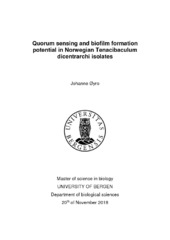Quorum sensing and biofilm formation potential in Norwegian Tenacibaculum dicentrarchi isolates
Master thesis
Permanent lenke
http://hdl.handle.net/1956/19016Utgivelsesdato
2018-11-20Metadata
Vis full innførselSamlinger
Sammendrag
Fish farming has become one of the most important industries in Norway. To handle further growth, both in sea- and land-based facilities, challenges should be dealt with in a sustainable manner. Among these challenges are bacterial infections. New promising treatment methods are being developed, targeting the communication between the bacteria. This communication is referred to as quorum sensing, which enables the bacteria to act in a coordinated way, depending on cell density. The bacteria produce molecules called autoinducers that diffuse away from the cell, and at high autoinducer concentrations certain genes become up- or downregulated. This autoinducer regulated gene control includes biofilm regulating processes and other features often included in virulence. In this thesis, indications of autoinducer production in the T. dicentrarchi strains were found using Vibrio harveyi reporter strains. These reporters react to AHL and AI-2, two of the most common autoinducers. The Tenacibaculum strains did not show indications of producing short chain AHLs, which can be tested when a Chromobacterium violaceum reporter strain is used. Furthermore, bioassays showed indications that the Tenacibaculum strains are capable of biofilm production. Both quorum sensing and biofilm activity, and how they are connected, are important aspects to fully understand when targeting the virulence of bacteria in new methods as alternatives to antibiotics.
